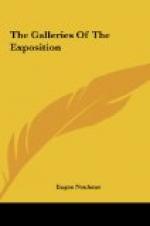Watercolours make up the chief problems of study in this long room, without convincing one that we have any too many great painters in this medium. The best thing among the many commonplace paintings is a marine by Woodbury which takes you far out on the open sea. In spite of its size it is a big picture, one of the really big ones in any medium in the whole exhibition. All of Woodbury’s paintings are big in their way, and prove what can be done in this medium. Many other things here are only coloured photographs and technical experiments, the exceptions being Dawson’s clever flower studies, Miss Schille’s market scenes, and Henry McCarter’s “King of Tara”. Murphy’s small Venetian sketches are not so good as they seem at first.
Gallery 36.
Things look up considerably in the last of the galleries on the north. A fine watercolour by Mrs. Mathews, good drawings by Sandona and Fortune, exposition sketches by Donna Schuster, decorative designs by Lucy Hurry, are all compelling in their way, while in the cases are any number of good caricatures, and especially worthy of mention the bird designs by Charles Emile Heil.
Gallery 34.
Across the vestibule the graphic arts are continued, beginning with colour lithographs and monotypes, and continued with etchings. George Senseney, Arthur Dow, Helen Hyde, Pedro Lemos, Clark Hobart, and others too numerous to mention excite considerable interest. A battle of elephants by Anna Vaughan Hyatt is worthy of study on account of its unusual subject, so handled.
Gallery 55.
This room is entirely devoted to etching and is full of good people. Auerbach Levy has some portraits splendidly characterized. Arthur Covey, Mahonri Young, Lester Hornby, Clifford Addams, and Robert Harshe are all equally well represented, in their many fine etchings, and Perham Nahl with some monotypes of fine quality.
Gallery 32 contains George Aid, Frank Armington, D. C. Sturges (reminiscent of Zorn), and Ernest Roth. Franklin T. Wood’s dry-point portraits are noteworthy as examples of a very difficult technique.
Galleries 31 and 30.
Pennell’s admirable lithographs and etchings of various scenes are so descriptive, aside from their technical excellence, that they are not in need of further recommendation. And neither are Mullgardt’s lithographs nor those of Worth Ryder next door.
The general character of all of these somewhat inconspicuous galleries is most satisfactory. They contain in well-arranged fashion the real art of the people, the things that people who cannot afford to buy paintings can easily afford to own. Original etchings, mezzotints, and wood block prints and other process work often more truly contain the real point of artistic effort than big paintings done laborously with no other interest than to make a large painting for some show. It is gratifying and it speaks well for our public to see so many of these small works of art sold and




